Table of contents
- Product test: engine oils SAE 10W-40 Motor oils in the test
- Motorcycle engine oils put to the test
- What’s the difference??
- The tasks of engine oil
- What is important when it comes to oil?
- Castrol Grand Prix S.
- Castrol Power 1 4T
- Castrol Power 1 Racing
- eleven Moto 4 Road
- eni i ride
- HEM motorcycle oil
- JMC engine oil 4T GP
- Motul 5000 4T
- Motul 300V Factory Line
- Performance 4T
- Procycle motor oil
- Racing Dynamic ViscOil 4T
- Rowe Formula 4-T
- Shell Advance AX 7
- Conclusion
- Oleology
- Dry sump lubrication
- Wet sump lubrication
- FAQs about oil
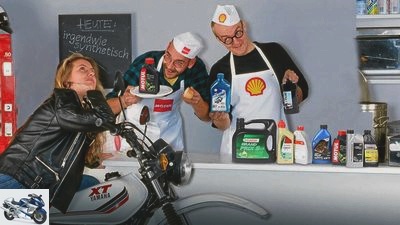
fact
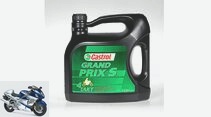
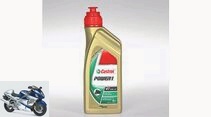
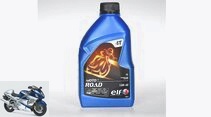
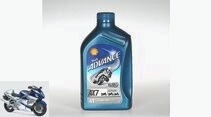
14th pictures
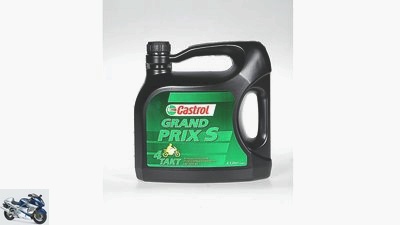
mps photo studio
1/14
Castrol Grand Prix S. MOTORRAD verdict: very good.
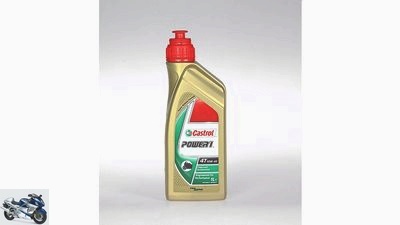
mps photo studio
2/14
Castrol Power 1 4T. MOTORRAD verdict: very good.

mps photo studio
3/14
eleven Moto 4 Road. MOTORRAD verdict: very good.
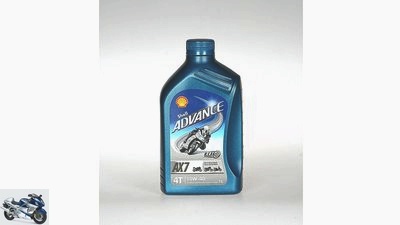
mps photo studio
4/14
Shell Advance AX7. MOTORRAD verdict: good.
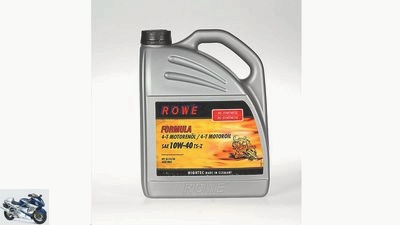
mps photo studio
5/14
Rowe Formula 4-T Motor Oil TS-Z. MOTORRAD verdict: good.
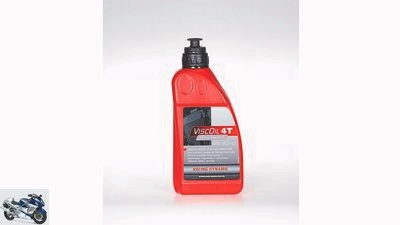
mps photo studio
6/14
Racing Dynamic ViscOil 4T. MOTORRAD verdict: very good.
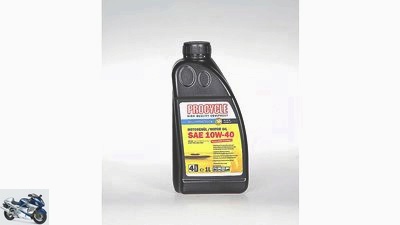
mps photo studio
7/14
Procycle motor oil. MOTORRAD verdict: very good.
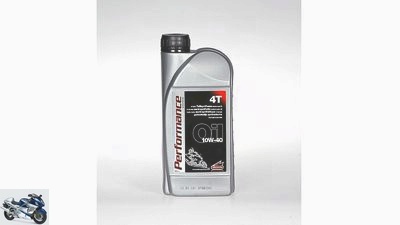
mps photo studio
8/14
Performance 4T. MOTORRAD verdict: very good.
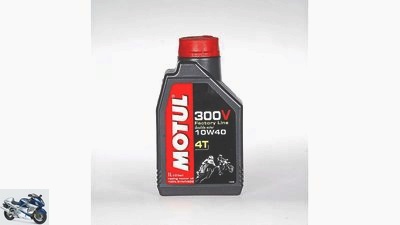
mps photo studio
9/14
Motul 300V Factory Line. MOTORRAD verdict: very good.
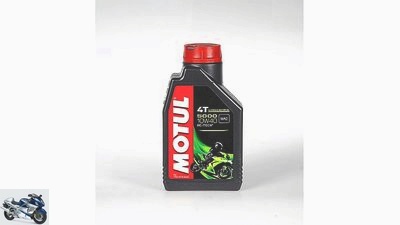
mps photo studio
10/14
Motul 5000 4T. MOTORRAD verdict: very good.
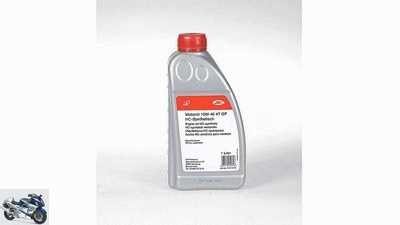
mps photo studio
11/14
JMC engine oil 4T GP. MOTORRAD verdict: good.

mps photo studio
12/14
HEM motorcycle oil. MOTORRAD verdict: good.
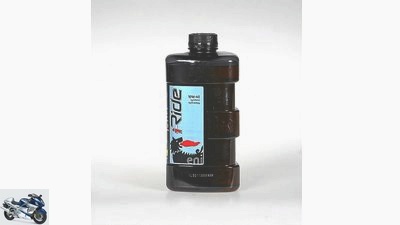
mps photo studio
13/14
eni i ride. MOTORRAD verdict: good.
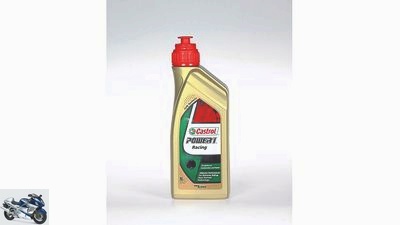
mps photo studio
14/14
The MOTORRAD test winner: Castrol Power 1 Racing. MOTORRAD verdict: very good.
counselor
technology & future
Product test: engine oil
Product test: engine oils SAE 10W-40
Motor oils in the test
Yes, what now? Mandy (19) wants to buy oil, but she can’t decide. Mineral, partially or fully synthetic? Or maybe the cold-pressed super quality from the deli? Don’t panic, if you pay attention to a few basics, you can hardly buy wrong.
Klaus Herder
04/07/2013
Motorcycle engine oils put to the test
One can make the subject a matter of faith. Some motorcyclists approach the matter with almost missionary zeal when the gasoline (!) Conversation turns to the subject of oil. Then it can only be a very specific brand under all circumstances. And also only fully synthetic, the best is just good enough. At the other end of the faith scale, some swear stone and leg that their engine has achieved a six-figure mileage even with the cheapest car oil from the hardware store and that a liter price of over three euros is a pure waste of money.
Buy complete article
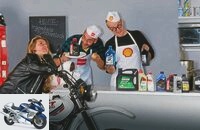
Product test: engine oils SAE 10W-40
Motor oils in the test
8 pages) as PDF
€ 2.00
Buy now
Before getting involved in discussions with such lubricant hardliners, it may help to acquire some basic knowledge and to clear up a few misunderstandings and prejudices. The first question that arises is: what is oil anyway? To put it simply: dead animals. To be more precise: dead microorganisms whose death occurred in prehistoric times. Chemists see things a little easier. For them, oil consists almost exclusively of the elements hydrogen and carbon.
What’s the difference??
In order for the carbon compounds to be turned into motorcycle oil, the crude oil must be broken down, cleaned and further processed in the refinery. Which brings us to the point where we can dispel the first misunderstanding: Even the most fully synthetic of all fully synthetic oils is based on crude oil. And that is like concrete: It depends on what you make of it. If a mineral base oil is refined, it becomes a so-called hydrocrack oil.
For the diverse uses of the oils, the mineral oil companies not only rely on Mother Nature and its hydrocarbon compounds, but also tinker with their own compounds. These substances, tailor-made in terms of their molecular structure, are called synthetic oils. The mixture of synthetically produced oils with mineral base oils results in a semi-synthetic oil. Important to know: All the great terms relating to refined oil (synthetic, fully synthetic, partially synthetic, polysynthetic, synthetic-based, HC synthesis and many more) are neither standardized nor capable of norms, i.e. pure marketing statements. A real indication of the real composition of an oil is not given.
The tasks of engine oil
The tasks of an engine oil are always the same: It has to lubricate, transmit forces, cool and seal. In addition, the oil is supposed to keep the oil-insoluble residues that occur during combustion in suspension until the next oil change. It has to neutralize acids, absorb water and protect against corrosion. It must only age a little, not foam and must remain flowable at all temperatures.
Such a base oil can only do this with the help of additives. These are active ingredients from the chemical kitchen that make up up to 25 percent of highly additive engine oil, consist of around ten to 15 different substances and are combined in tailor-made additive packages. These packages are mostly bought from suppliers; three major US and UK based providers dominate the market. The choice of additive packages is largely responsible for the large price differences. Are you dealing with a well-known phrase “off the shelf”, or has a lot of know-how and time been invested in a new development? These are very crucial questions for the subsequent sales price.
Buy engine oil on markt.motorradonline.de
Motul 5000 4T – Best purchase from MOTORRAD 15/2013
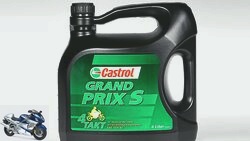
accesories
Best purchase engine oil Castrol Grand Prix S
Top quality at a (Castrol) competitive price
read more

Herder
FT infrared spectroscopy reveals that “fingerprint” of the oils.
Which brings us to the 14 motorcycle oils for this test. The prices differ very significantly in some cases. The liter price range for the recommended retail prices ranges from 7.39 to 19.95 euros, and in practice even from 5.20 to 19.99 euros. And that under the same basic conditions, which were: Viscosity SAE 10W-40 (this is still the category most frequently recommended by motorcycle manufacturers), API SG or higher, JASO MA or higher. Whether mineral, partially or fully synthetic, MOTORRAD wasn’t interested at all for the reasons mentioned at the beginning.
Mandy (19) and all other oil buyers should also proceed in a similarly systematic manner: The viscosity prescribed by the motorcycle manufacturer is always the first and no alternative selection criterion. Then you should pay attention to the API classification. API stands for the “American Petroleum Institute”, which classifies engine oils according to letter combinations. For gasoline engines, the first is always an S, the following letter should be at least a G. The SG classification was introduced in 1989, in the meantime you have arrived at SN, but this does not necessarily mean that an SG oil for the motorcycle has to be worse than an SN oil.
What is important when it comes to oil?

Herder
The viscometer will determine the viscosity, i.e. the flow behavior of the oils.
It is possible that the oil supplier only gave himself the (expensive) testing effort to “update” his oil. In addition, the API requirements are primarily designed to meet the needs of passenger car engines. However, the API classification does give an initial indication of the oil quality. For motorcyclists, however, the JASO classification (based on the API classification) is even more important. JASO stands for “Japan Automobile Standards Organization”, and even if the name suggests otherwise, it is specifically about the demands of motorcycle engines when JASO MA (or MA1 or MA2) is on the oil can. This ensures that the oil can cope with the oil bath clutches that are common in motorcycle engines. The JASO MA marking is the only existing specification for four-stroke motorcycle engine oils and should be the most important oil purchase criterion after the correct viscosity specification.
The 14 motorcycle oils bought by MOTORRAD all meet the viscosity specifications, and the sulphated ash content, which according to JASO may be a maximum of 1.2 percent by weight, was undercut by all suppliers. But what are the differences? Unfortunately, the breakdown of the additive composition is not as easy to interpret as a chemical layperson might assume. “A lot helps a lot” does not really apply, but the reverse is also not permissible. Very roughly simplified, one can say that calcium, magnesium and boron are mainly used as detergents and dispersants, that is, they take care of keeping lubricated surfaces clean and keeping dirt particles in suspension. Zinc, phosphorus and sulfur in turn serve to protect against wear. The crux of the matter: All additive components (and not all of them are mentioned in the FAQ and Oil Science chapters) interact with one another.
So if you have not just recently completed a chemistry degree, you can confidently concentrate on reading the conclusion and otherwise shop with peace of mind. There is no real outlier among the test participants, the fully synthetic freaks should discover their favorites very quickly, and the bargain hunters will also find what they are looking for. Okay, there is no suitable motorcycle oil for three euros, but less than ten euros per liter is quite feasible. Cold-pressed, however, does not work at all.
Castrol Grand Prix S.
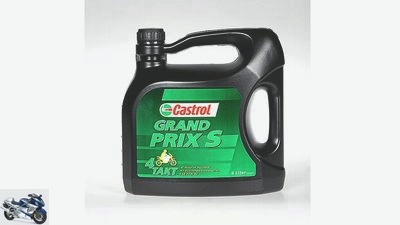
mps photo studio
Castrol Grand Prix S. MOTORRAD verdict: very good.
Specification: 10W-40, semi-synthetic, API SG, JASO MA
Providers: Deutsche Castrol Vertriebsgesellschaft mbh, 22761 Hamburg; www.castrol.com/de
Price per liter (RRP / actually paid): in a 4-liter container 9.99 euros / 7.50 euros (special offer at Polo, Stuttgart)
viscosity (mm² / s): at 40 ° C: 86.55; at 100 ° C: 13.29; Viscosity index: 155
Additives: (mg / kg): Calcium: 1199, Magnesium: 741, Boron: 60, Zinc: 882, Phosphorus: 780, Molybdenum: 45, Sulfur: 4490
Additional tests: BN (mgKOH / g): 10.35; Sulphated ash (wt%): 0.81
Conclusion: The special bottling for polo (also available as “Grand Prix” at Louis) has the age-old specification API SG. Probably also to differentiate them from the more expensive Castrol premium products. The additives are not ultra-modern, but completely okay and suitable for motorcycles – top quality at a (Castrol) competitive price
MOTORRAD verdict: very good
Castrol Power 1 4T
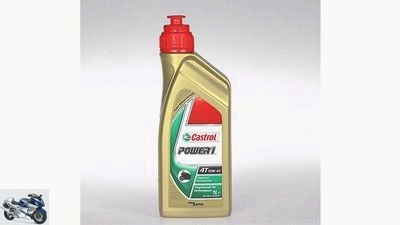
mps photo studio
Castrol Power 1 4T. MOTORRAD verdict: very good.
Specification: 10W-40, semi-synthetic, API SJ, JASO MA2
Providers: Deutsche Castrol Vertriebsgesellschaft mbh, 22761 Hamburg; www.castrolmoto.com
Price per liter (RRP / actually paid): 16.95 euros / 16.50 euros (at Polo, Stuttgart)
viscosity (mm² / s): at 40 ° C: 85.93; at 100 ° C: 13.44; Viscosity index: 159
Additives (mg / kg): Calcium: 1233, Magnesium: 765, Boron: 63, Zinc: 903, Phosphorus: 795, Molybdenum: 46, Sulfur: 4454
Additional tests: BN (mgKOH / g): 10.72; Sulphated ash (wt%): 0.89
Conclusion: If you look at the infrared spectrum of the “Power 1” and the “Castrol Grand Prix S” (see left), you will see: very, very similar. A rogue who thinks marketing. According to Castrol, the products have very different additives, of course. Is clear. The same applies here: a top oil, not quite as cheap.
MOTORRAD verdict: very good.
Castrol Power 1 Racing
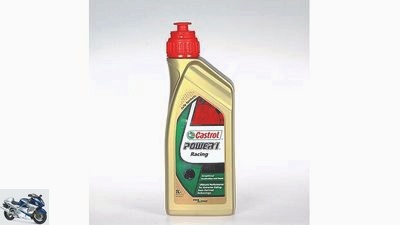
mps photo studio
The MOTORRAD test winner: Castrol Power 1 Racing. MOTORRAD verdict: very good.
Specification: 10W-40, fully synthetic, API SL, JASO MA2
Providers: Deutsche Castrol Vertriebsgesellschaft mbh, 22761 Hamburg; www.castrolmoto.com
Price per liter (RRP / actually paid): 18.95 euros / 12.99 euros (special offer from Detlev Louis, Stuttgart)
viscosity (mm² / s): at 40 ° C: 86.53; at 100 ° C: 12.91; Viscosity Index: 148
Additives: (mg / kg): Calcium: 1197, Magnesium: 745, Boron: 66, Zinc: 880, Phosphorus: 769, Molybdenum: 43, Sulfur: 2446
Additional tests: BN (mgKOH / g): 10.43; Sulphated ash (wt%): 0.83
Conclusion: Here, too, the additive package looks somehow familiar – see “Grand Prix S” and “Power 1”. The lower sulfur content suggests that a higher quality base oil is involved. The result is a recipe perfectly matched for motorcycle use and the test victory.
MOTORRAD verdict: very good.
eleven Moto 4 Road
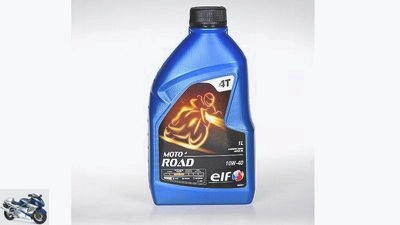
mps photo studio
eleven Moto 4 Road. MOTORRAD verdict: very good.
Specification: 10W-40, semi-synthetic, API SJ, JASO MA2
Providers: Total Lubrifiants, 92000 Nan-terre / France; www.lubricants.elf.com
Price per liter (RRP / actually paid): 15.75 euros / 15.75 euros (at Motorrad Service W. Rodler, Filderstadt)
viscosity (mm² / s): at 40 ° C: 95.84; at 100 ° C: 14.62; Viscosity index: 159
Additives: (mg / kg): Calcium: 1534, Magnesium: 4, Boron: 86, Zinc: 863, Phosphorus: 746, Molybdenum: 44, Sulfur: 6579
Additional tests: BN (mgKOH / g): 7.41; Sulphated ash (wt%): 0.71
Conclusion: The French have a lot of motorcycling experience and you can tell from this oil. The sulphated ash content is quite low, so deposits are likely to be below average. Additivation is relatively modern. The bottom line is a very good, inconspicuous oil at an acceptable price.
MOTORRAD verdict: very good.
eni i ride
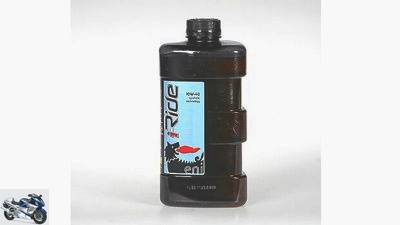
mps photo studio
eni i ride. MOTORRAD verdict: good.
Specification: 10W-40, semi-synthetic, API SL, JASO MA / MA2
Providers: eni s.p.a, 449 Rome / Italy; www.eni.com
Price per liter (RRP / actually paid): 12.49 euros / 14.99 euros (at Agip, Stuttgart)
viscosity (mm² / s): at 40 ° C: 95.79; at 100 ° C: 13.61; Viscosity index: 143
Additives: (mg / kg): Calcium: 2454, Magnesium: 253, Boron: 171, Zinc: 1053, Phosphorus: 907, Molybdenum: 0, Sulfur: 6989
Additional tests: BN (mgKOH / g): 11.08; Sulphated ash (wt%): 1.06
Conclusion: The additive package is not very typical for a motorcycle and would be more suitable for a diesel engine oil. The relatively high proportion of ash-giving components is noticeable and disturbing. The assumption is that it is not a special motorcycle oil development, but rather a variation of another oil.
MOTORRAD verdict: Good.
HEM motorcycle oil
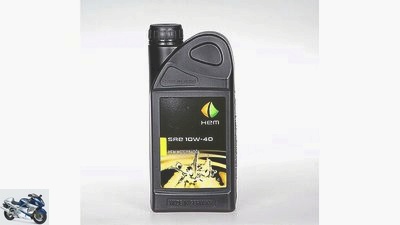
mps photo studio
HEM motorcycle oil. MOTORRAD verdict: good.
Specification: 10W-40, mineral, API SL, JASO MA2
Providers: Deutsche Tamoil GmbH, 25337 Elmshorn; www.tamoil.de
Price per liter (RRP / actually paid): 12.99 euros / 12.99 euros (at HEM, Kornwestheim)
viscosity (mm² / s): at 40 ° C: 89.03; at 100 ° C: 13.98; Viscosity index: 161
Additives: (mg / kg): calcium: 1975, magnesium: 5, boron: 77, zinc: 849, phosphorus: 725, molybdenum: 2, sulfur: 3151
Additional tests: BN (mgKOH / g): 8.99; Sulphated ash (wt%): 0.98
Conclusion: A mineral oil with a fairly high viscosity index and a rather low sulfur content. This suggests a good base oil, but can lead to certain compromises in the case of very high loads. Average oil in every way. Price / performance not necessarily optimal.
MOTORRAD verdict: Good.
JMC engine oil 4T GP
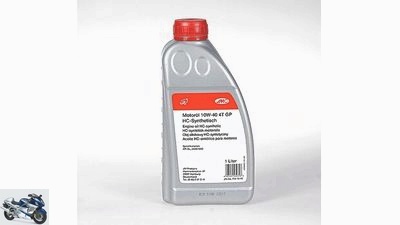
mps photo studio
JMC engine oil 4T GP. MOTORRAD verdict: good.
Specification: 10W-40, semi-synthetic, API SL, JASO MA2
Providers: JM-Products, 20097 Hamburg; www.jmproducts.eu
Price per liter (RRP / actually paid): 8.54 euros / 8.55 euros (at Heller & Soltau, St. Michaelisdonn)
viscosity (mm² / s): at 40 ° C: 91.25; at 100 ° C: 13.77; Viscosity Index: 154
Additives: (mg / kg): Calcium: 2524, Magnesium: 4, Boron: 3, Zinc: 894, Phosphorus: 804, Molybdenum: 80, Sulfur: 2589
Additional tests: BN (mgKOH / g): 8.90; Sulphated ash (wt%): 1.06
Conclusion: The additives are rather high giving ash, the base number is slightly below average, and the sulphate ash content is at the top – a very good motorcycle oil looks a little different. The base oil is guaranteed not to save, but it is only enough for a place in the second half of the table.
MOTORRAD verdict: Good.
Motul 5000 4T
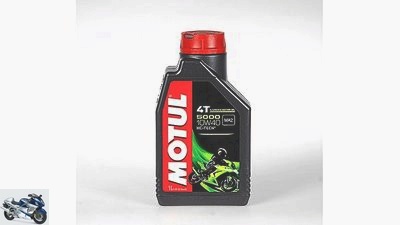
mps photo studio
Motul 5000 4T. MOTORRAD verdict: very good.
Specification: 10W-40, semi-synthetic, API SL, JASO MA2
Providers: Motul, 93300 Aubervilliers / France; www.motul.com
Price per liter (RRP / actually paid): 11.75 euros / 9.80 euros (at Heller & Soltau, St. Michaelisdonn)
viscosity (mm² / s): at 40 ° C: 98.07; at 100 ° C: 14.87; Viscosity index: 159
Additives: (mg / kg): Calcium: 1779, Magnesium: 8, Boron: 8, Zinc: 907, Phosphorus: 797, Molybdenum: 23, Sulfur: 5133
Additional tests: BN (mgKOH / g): 7.96; Sulphated ash (wt%): 0.77
Conclusion: The additives are tailor-made for motorcycle use. You can tell that the oil is specifically designed. The very low sulphated ash content is another plus point. The fact that modern oil is also rather cheap (and in practice is sometimes traded below the RRP) makes things even more appealing.
MOTORRAD verdict: very good.
Motul 300V Factory Line
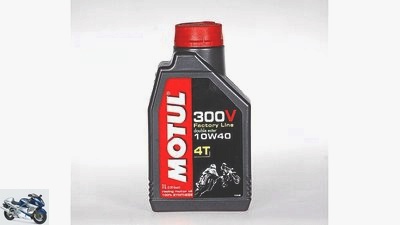
mps photo studio
Motul 300V Factory Line. MOTORRAD verdict: very good.
Specification: 10W-40, fully synthetic, “exceeds JASO MA and API SL” (according to Gericke catalog; no information on packaging)
Providers: Motul, 93300 Aubervilliers / France; www.motul.com
Price per liter (RRP / actually paid): 19.95 euros / 19.99 euros (at Hein Gericke, Stuttgart)
viscosity (mm² / s): at 40 ° C: 78.61; at 100 ° C: 12.56; Viscosity index: 159
Additives: (mg / kg): calcium: 2390, magnesium: 4, boron: 126, zinc: 963, phosphorus: 856, molybdenum: 161, sulfur: 3150
Additional tests: BN (mgKOH / g): 9.55; Sulphated ash (wt%): 0.97
Conclusion: Very high-quality base oils are likely to be used here, the statement “fully synthetic” is absolutely credible. A top oil, the viscosity of which is at the lower limit for a 10 W-40. The price is steep, non-racers are probably better off with the semi-synthetic sister product.
MOTORRAD verdict: very good.
Performance 4T
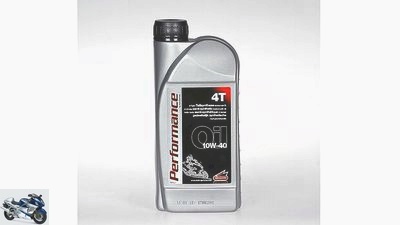
mps photo studio
Performance 4T. MOTORRAD verdict: very good.
Specification: 10W-40, partly synthetic, “corresponds to: API SG; JASO MA “(according to Gericke catalog; no information on packaging)
Providers: H. Gericke Germany GmbH, 40589 Dusseldorf; www.hein-gericke.com
Price per liter (RRP / actually paid): 8.95 euros / 8.95 euros (at Hein Gericke, Stuttgart)
viscosity (mm² / s): at 40 ° C: 99.00; at 100 ° C: 15.08; Viscosity index: 160
Additives: (mg / kg): Calcium: 2277, Magnesium: 5, Boron: 88, Zinc: 938, Phosphorus: 819, Molybdenum: 3, Sulfur: 6990
Additional tests: BN (mgKOH / g): 9.11; Sulphated ash (wt%): 0.83
Conclusion: The Gericke house brand is bottled by Motul, but is not identical to the original Motul products tested here. The recipe corresponds to a typical motorcycle oil, but should be a bit older – API SG (according to catalog) sends its regards. Decent goods, but not really modern anymore.
MOTORRAD verdict: very good.
Procycle motor oil

mps photo studio
Procycle motor oil. MOTORRAD verdict: very good.
Specification: 10W-40, semi-synthetic, API SM, JASO MA2
Providers: Detlev Louis Motorradvertriebsges. mbH, 21027 Hamburg; www.louis.de
Price per liter (RRP / actually paid): 8.99 euros / 8.99 euros (at Detlev Louis, Stuttgart)
viscosity (mm² / s): at 40 ° C: 89.02; at 100 ° C: 13.19; Viscosity Index: 148
Additives: (mg / kg): calcium: 1864, magnesium: 9, boron: 2, zinc: 968, phosphorus: 848, molybdenum: 1, sulfur: 3722
Additional tests: BN (mgKOH / g): 8.22; Sulphated ash (wt%): 0.68
Conclusion: Louis has the German Pentosin in Wedel bottled and receives decent goods with quite modern additives. The high aromatic content suggests a rather cheap base oil. The sulphate ash content is gratifyingly low. The price-performance ratio is right.
MOTORRAD verdict: very good.
Racing Dynamic ViscOil 4T
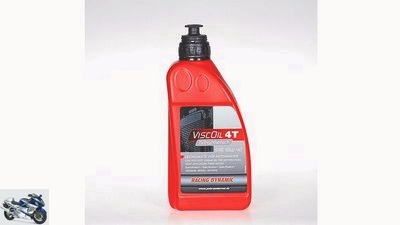
mps photo studio
Racing Dynamic ViscOil 4T. MOTORRAD verdict: very good.
Specification: 10W-40, partly synthetic, API SG, JASO MA (according to Polo catalog API SL and JASO MA2)
Providers: Polo-Expressversand GmbH, 41363 Juchen; www.polo-motorrad.de
Price per liter (RRP / actually paid): 8.99 euros / 8.99 euros (at Polo, Stuttgart)
viscosity (mm² / s): at 40 ° C: 95.63; at 100 ° C: 14.25; Viscosity index: 153
Additives: (mg / kg): calcium: 1860, magnesium: 4, boron: 72, zinc: 806, phosphorus: 707, molybdenum: 2, sulfur: 5731
Additional tests: BN (mgKOH / g): 8.96; Sulphated ash (wt%): 0.89
Conclusion: Another house brand: Polo has the Fuchs company as its supplier, and Fuchs oils are the first fillings for many car manufacturers. But the Mannheim-based company also does a decent job in the motorcycle sector. The base oil should not be of absolute top quality, but the additives are consistent.
MOTORRAD verdict: very good.
Rowe Formula 4-T
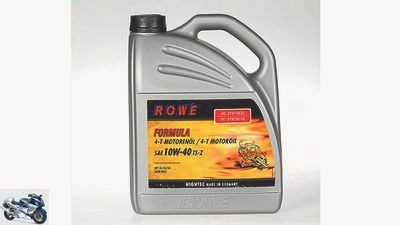
mps photo studio
Rowe Formula 4-T Motor Oil TS-Z. MOTORRAD verdict: good.
Specification: 10W-40, semi-synthetic, API SL, JASO MA2
Providers: Rowe Mineralolwerk GmbH, 67308 Bubenheim; www.rowe-mineraloel.com
Price per liter (RRP / actually paid): in a 5 liter container 7.39 euros / 5.20 euros (at Polo, Stuttgart)
viscosity (mm2 / s): at 40 ° C: 101.41; at 100 ° C: 14.72; Viscosity index: 151
Additives: (mg / kg): Calcium: 2483, Magnesium: 4, Boron: 2, Zinc: 851, Phosphorus: 766, Molybdenum: 82, Sulfur: 2795
Additional tests: BN (mgKOH / g): 9.00; Sulphated ash (wt%): 1.02
Conclusion: A very good base oil quality is probably involved. The somewhat ashy additives are more suitable for a (possibly slightly modified) car oil. The sulphated ash content is relatively high – bad for highly stressed motorcycle engines. Extremely interesting for “non-stokers”: the low price.
MOTORRAD verdict: Good.
Shell Advance AX 7
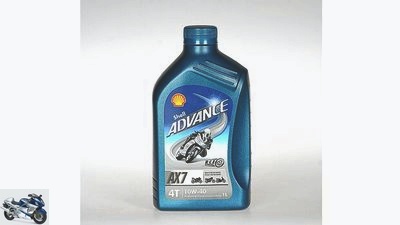
mps photo studio
Shell Advance AX7. MOTORRAD verdict: good.
Specification: 10W-40, semi-synthetic, API SL, JASO MA2
Providers: Shell Germany Oil GmbH, 22335 Hamburg; www.shell.com
Price per liter (RRP / actually paid): 15.95 euros / 15.99 euros (at Shell, Stuttgart)
viscosity (mm2 / s): at 40 ° C: 94.69; at 100 ° C: 14.59; Viscosity index: 160
Additives: (mg / kg): Calcium: 2606, Magnesium: 11, Boron: 78, Zinc: 976, Phosphorus: 852, Molybdenum: 1, Sulfur: 6679
Additional tests: BN (mgKOH / g): 11.31; Sulphated ash (wt%): 1.06
Conclusion: The dynamic packaging shouldn’t deceive you: it probably doesn’t contain a very modern oil. Should we possibly be sold the good old VSX4 with a new name? The base oil technology is quite up-to-date, but unfortunately no motorcycle oil comes out of it, rather diesel car oil.
MOTORRAD verdict: Good.
Conclusion
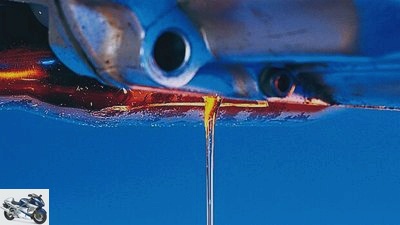
mps photo studio
The first step when changing the oil: drain the old oil.
| viscosity | Additives | Additional tests | total | MOTORRAD verdict * | Price per liter in euros | |
| maximum number of points | 30th | 35 | 35 | 100 | ||
| Castrol Power 1 Racing | 30th | 32 | 33 | 95 | very good | 18.95 |
| Castrol Power 1 4T | 30th | 30th | 34 | 94 | very good | 16.95 |
| Motul 5000 4T | 30th | 32 | 32 | 94 | very good | 11.75 |
| Castrol Grand Prix S. | 30th | 28 | 34 | 92 | very good | 9.99 |
| eleven Moto 4 Road | 30th | 30th | 32 | 92 | very good | 15.75 |
| Motul 300V Factory Line | 30th | 29 | 32 | 91 | very good | 19.95 |
| Procycle motor oil | 30th | 25th | 32 | 87 | very good | 8.99 |
| Performance 4T | 30th | 23 | 32 | 85 | very good | 8.95 |
| Racing Dynamic ViscOil 4T | 30th | 23 | 32 | 85 | very good | 8.99 |
| JMC engine oil 4T GP | 30th | 22nd | 31 | 83 | Good | 8.54 |
| HEM motorcycle oil | 30th | 20th | 31 | 81 | Good | 12.99 |
| Rowe Formula 4-T TS-Z | 30th | 20th | 31 | 81 | Good | 7.39 |
| Shell Advance AX7 | 30th | 18th | 33 | 81 | Good | 15.95 |
| eni i ride | 30th | 17th | 33 | 80 | Good | 12.49 |
* 100 to 85 points = very good; 84 to 70 points = good; 69 to 55 points = satisfactory; 54 to 40 points = sufficient; 39 to 0 points = unsatisfactory
Conclusion
Surprises and scandals? Nothing. The tested products offer consistently good and very good quality. The promised viscosity is fulfilled by everyone; in terms of base number (BN) and sulphated ash content – summarized under “additional tests” – there are also no outliers. If anything, oil experts discern differences in the additives, and infrared spectroscopy allows inter alia. certain statements about whether high-quality base oils are used in the product and whether the oil was developed very specifically for motorcycle use. The seven first placed play in the top class; it is followed by a solid midfield that can also be recommended without hesitation. The three last placed also deliver decent quality, but are not very “typical of a motorcycle”.

accesories
The best motorcycle accessories
Overview of motorcycle accessory tests
read more
Oleology
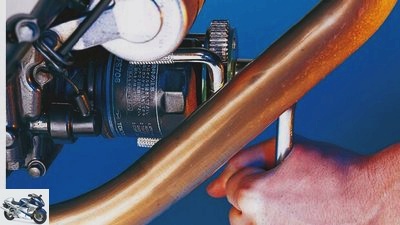
mps photo studio
Should always be replaced when changing the oil: the filter.
Wet sump lubrication is standard on four-stroke motorcycles today, but dry sump lubrication is still justified for certain purposes. Here is some basic knowledge about the advantages and disadvantages of both systems.
Dry sump lubrication
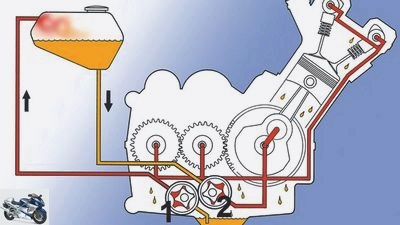
Supervision of the dry sump lubrication.
The schematic diagram clearly shows the advantages and disadvantages of this system. In direct comparison to wet sump lubrication, the lower overall height of the oil pan is noticeable, which increases the ground clearance – a great advantage for enduro bikes or tall engines (Harley-Davidson V2). Thanks to the compact oil tank, which is often provided with baffles, the oil is reliably available for lubrication even with high g-forces (acceleration, braking).
A second pump is required to suck up the oil from the small oil pan and transport it to the oil tank. When entering the oil tank, it is advantageous if the oil jet is swirled and thereby loosens air bubbles from the oil. The return pump (1) must deliver a significantly higher delivery rate than the pressure pump (2). This is the only way to ensure that the oil tank is sufficiently refilled in all speed ranges and that the pressure pump cannot suck in air. If the oil tank is placed above the engine housing, the oil seeps out of the tank via the oil pressure pump into the engine when the tank is idle for a long time, which is why the driver’s manuals for checking the oil level describe a certain, often somewhat more complex procedure.
Wet sump lubrication
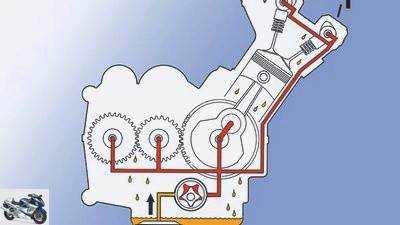
Supervision of the wet sump lubrication
All that is required here is a pressure pump that sucks the oil out of the large and deeply set oil pan (yellow) and presses it to the lubrication points with a pressure of around 3.5 bar (red circuit). The oil is stored at the bottom of the engine, which significantly increases the overall height. If the oil pan and thus the oil level were installed too high, the crankshaft and clutch would transform the lubricant into a foamy emulsion of air and oil, which of course would drastically impair the cooling and lubricating effect.
While on motorcycles when cornering, the oil hardly escapes to the side due to the inclined position, in four-wheeled vehicles it is pushed to the outer wall of the oil pan due to the high centrifugal forces, which in long curves can cause a breakdown of the oil circuit and thus the lubrication due to insufficient oil level. With motorcycles, it becomes critical when the driver does long wheelies in a strong position and the oil shifts from the oil pan to the rear of the engine housing. In contrast to the early 1970s, when motorcycle engines often had to struggle with insufficient lubrication of the distant camshaft bearings (1) after a cold start, nowadays powerful oil pumps and sophisticated lubrication systems also reliably supply these bearing points with oil.
Engine oil change made easy – that’s how it works
Drain the old oil: To make the oil thinner, let the engine warm up or run for a few minutes. For better drainage, remove the filler plug, then open the drain plug (at the bottom of the engine) and collect the oil.
Filter change: The filter should always be replaced when changing the oil. Before installing the new cartridge filter, lightly (!) Coat the sealing ring with oil, then tighten it by hand and then with a torque wrench.
Fill in new oil: Insert the drain plug provided with a new sealing ring and tighten to the correct torque, do not jam, the thread is sensitive. Then fill in the amount of oil specified in the manual.
Control: Let the engine run for a short time so that the oil is distributed inside. Switch off the engine, wait about a minute, then check the oil level using the sight glass or dipstick according to regulations and correct if necessary.
FAQs about oil
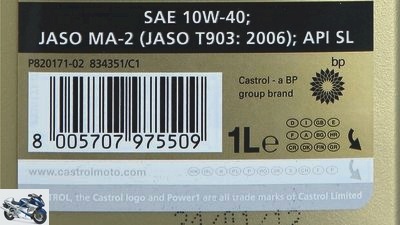
mps photo studio
The most important information: viscosity (here 10W-40); the JASO specification (MA, MA1, MA2 – here JASO MA2) reveals that the oil is suitable for four-stroke motorcycles with an oil bath clutch; the API classification (here SL) should be between SG and SN.
That is often asked
The phrase “talking about gasoline” is actually completely out of the ordinary. “Talking about oil” would be much more appropriate, because discussions about lubricants are one of the most popular round table topics when motorcyclists talk about technology. Or when they request greasy answers from their trusted motorcycle magazine. The most common oil questions can be found here in quick succession:
Are motorcycle oils different from car oils??
You should at least be different, because the requirements are very different. Motorcycle engines usually achieve very high liter outputs and require much higher speeds than car engines and also get hotter. Air-cooled motorcycle engines in particular put more stress on the oil than almost exclusively water-cooled car engines. In addition, in almost all motorcycles, the oil has to supply the gearbox and clutch and is exposed to strong, shear loads. High-performance car engine oils are completely unsuitable for motorcycles, as they can contain additives that change the friction behavior of the oil bath clutches in such a way that damage can occur.
Synthetic oils are better?
Not basically. A great mineral oil can do more than a mediocre synthetic oil. High-quality synthetic oils are clearly superior to mineral oils. They are more thermally resilient, age less and ensure cleaner engines. The wear protection is also better.
Can mineral oils be mixed with synthetic oils??
Yes, all engine oils must be mixable with one another. However, the performance characteristics of the mixed product change towards the lower quality oil, i.e. mineral oil.
Does the oil paint say something about the quality?
No, because if the new lubricant turns dark brown shortly after the oil change, this only shows that the oil is doing its job, namely keeping the dirt in suspension and preventing deposits. In addition, when the oil is changed, there are always a few milliliters of used oil in the engine, which mixes with the fresh oil and immediately turns it dark.
Ages oil during the winter break?
Yes and no, of course every oil that comes into contact with oxygen ages, but a service life of up to a year is no problem for a fresh oil. You should therefore change the oil before the winter break. Fresh oil in a closed, frost-proof canister can be stored for up to three years in closed rooms without UV light – at least that’s the recommendation of the Castrol oil experts.
An annual oil change is also recommended if the annual mileage is significantly below the maintenance interval?
Absolutely, especially when the few kilometers have come together with many cold starts and short-haul operations. This means that even oils with low mileage may have reached the end of their power reserves. The oil change required by some motorcycle manufacturers annually and regardless of the mileage is therefore definitely justified.
Do you still have to warm up modern engines??
Yes, that’s better, because engine oil only “works” from around 50 degrees, and the running clearance of the mechanics only has the correct value at operating temperature. It can take 30 seconds and more under wintry conditions until the oil has reached the last engine angle. But even in summer temperatures it makes sense and is gentler on the material in the long run to cover at least the first five kilometers with a maximum of half-throttle.
What is the value of the oil control lamp?
A completely overrated. When it lights up, it is often too late. Regular classic oil level checks are irreplaceable.
Related articles
-
Test winner engine oil (MOTORRAD 15-2013)
mps photo studio accesories Test winner engine oil (MOTORRAD 15/2013) Test winner engine oil (MOTORRAD 15/2013) Castrol Power 1 Racing The engine oil…
-
Product test full face helmets with sun visor
Photo: Herder 51 pictures mps photo studio 1/51 Airoh Movement, MOTORRAD verdict: very good (motorcycle purchase tip). mps photo studio 2/51 HJC RPHA ST,…
-
Product test: neck warmers, balaclavas
MPS photo studio clothing Product test: neck warmers, balaclavas Product test: neck warmer Weather protection for the head, neck and neck Balaclavas,…
-
Lashing systems in the product test
fotolia 27 pictures mps photo studio 1/27 BGS Spannband Doppelpac, MOTORRAD judgment: satisfactory. Dentges 2/27 Joubert clamping rubber Safe with clever…
-
On – off-road helmets in the product test
Herder 48 pictures mps photo studio 1/48 … all the rest too. mps photo studio 2/48 Nice idea, implemented unsatisfactorily – the modular helmet is a…
-
mps photo studio clothing gloves Product test: gloves Product test: gloves Gloves for cold days Bright to cool to wet and cold? On Germany’s highest pass…
-
Product test: all-round gloves
jkuenstle.de clothing gloves Product test: all-round gloves Product test: gloves All-round gloves in comparison Anyone who wants to play the piano with…
-
Product test: the right functional underwear for every season
mps photo studio clothing Product test: the right functional underwear for every season Product test: year-round functional underwear (with video) The…
-
All-round motorcycle gloves up to 50 euros in the product test
van der Ems 17th pictures mps photo studio 1/17 Picture gallery: All-round gloves up to 50 euros in the product test. mps photo studio 2/17 Probiker…
-
Inexpensive touring boots in the product test
MPS photo studio clothing Boots Inexpensive touring boots in the product test Inexpensive touring boots in a comparison test How waterproof and high…